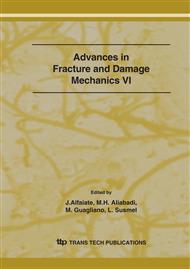p.817
p.821
p.825
p.829
p.833
p.837
p.841
p.845
p.849
Damage Constitutive Relationship of SRC Member Nonlinear Analysis
Abstract:
The damage constitutive relationship is a key problem to nonlinear analysis of structural members. It is much more necessary to study systematically related damage constitutive relationship of steel reinforced concrete (SRC) members because of their peculiarity. Based on the experimental phenomena analysis and damage theory, the mesoscopic failure mechanism of concrete as well as the interface of shaped steel and concrete is analyzed. At the same time, their mesoscopic damage models and corresponding assumptions of the models are established by considering material failure characteristics. Subsequently, the mechanism of the models is analyzed, which indicates that they fit to simulate failure process of the materials. According to the models, the related damage constitutive relationship for SRC members is deduced by principle of energy and force balance. Combined with corresponding experimental study, it is shown that the constitutive relationship presented is reasonable and practicable, so it facilitates SRC member nonlinear analysis.
Info:
Periodical:
Pages:
833-836
Citation:
Online since:
September 2007
Authors:
Price:
Сopyright:
© 2007 Trans Tech Publications Ltd. All Rights Reserved
Share:
Citation:


